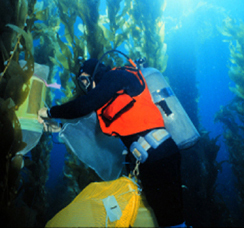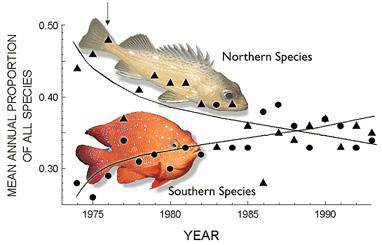|
POPULATION
TRENDS
AND TROPHIC DYNAMICS IN PACIFIC OCS
ECOSYSTEMS: WHAT CAN MONITORING DATA TELL US?
Principal Investigators:
Russell J. Schmitt (UCSB) and
Andrew J.
Brooks (UCSB)
Project Rationale:
 A number of
entities, including MMS, have devoted considerable effort and resources
to the
long-term monitoring of various components of the coastal marine
ecosystems in
the Southern California outer-continental shelf (OCS) region. The primary goals of such monitoring programs
are to
estimate the current state of the biota and to identify long-term
trends in
population demographics. Data from such
studies are vital to resource and regulatory agencies as they provide
critical
baseline information needed for accurate assessment of potential
effects
arising from such particular activities as offshore oil and gas
production. The fundamental need for
such information is evidenced by the growing number of coastal marine
monitoring programs that have been implemented in Southern California. A number of
entities, including MMS, have devoted considerable effort and resources
to the
long-term monitoring of various components of the coastal marine
ecosystems in
the Southern California outer-continental shelf (OCS) region. The primary goals of such monitoring programs
are to
estimate the current state of the biota and to identify long-term
trends in
population demographics. Data from such
studies are vital to resource and regulatory agencies as they provide
critical
baseline information needed for accurate assessment of potential
effects
arising from such particular activities as offshore oil and gas
production. The fundamental need for
such information is evidenced by the growing number of coastal marine
monitoring programs that have been implemented in Southern California.
The
behavior of the California Current System plays a critical role in
determining
the conditions of the nearshore marine environment off Southern
California. The typically high
productivity of this system is attributed to coastal upwelling which
brings
deeper, nutrient-rich water to the surface near shore.
This high supply rate of nutrients enhances
primary productivity, which in turn increases secondary productivity of
the
nearshore pelagic and benthic food webs.
Time series studies of the California Current System
conducted by the
California Cooperative Fisheries Oceanic Investigations since the
1940’s have
revealed distinct seasonality within a year, and periodic wholesale
change
during El Niño Southern Oscillation (ENSO) events that have relatively
brief
(1-2 years) durations. There is
abundant evidence that the California Current System has undergone a
longer,
interdecadal length change since the late 1970’s and early 1980’s. One manifestation off Southern California of
this apparent regime shift was a rapid, large, and persistent increase
in
seawater temperature. Between
1976-1977, mean annual surface temperatures in the Southern California
Bight
rose an average of 1oC or more above the mean for the
previous two
decades. Associated with this warming
event were a number of changes in other physical processes and events
that can
influence marine biota. Among the more
important manifestations in Southern California of these altered
physical
conditions was a decrease in productivity in surface waters near shore. Although the exact physical explanation is
still under study, it appears reasonably certain that the amount of
nutrients
upwelled into surface waters has declined during this recent period of
elevated
seawater temperature. There is
compelling evidence that the abundances of many coastal species off
Southern
California have undergone dramatic declines over the past 1-2 decades
in
response to falling productivity in near shore, surface waters.
 The vast
amount of long-term data on nearshore biota
collected by a large number of separate monitoring programs in the
Southern
California OCS region represents a relatively untapped “gold mine” of
information for environmental managers.
The occurrence of a regime shift in the ocean
climate in the North
Pacific in the past two decades provides a unique opportunity to
determine
whether and how various components of the biota respond to this source
of
perturbation. Data from long-term
monitoring programs not only indicate the current state and recent
history of
the biota, they can revel much about the ecological structure of
various
coastal ecosystems, including the dynamical behavior and regulation of
different food webs. Such knowledge
provides managers with better understanding and enhanced predictive
ability
regarding the potential impacts to these ecosystems from other
potential
sources of disturbance. Further,
analyses of existing data sets can expose whether and how our ability
to
estimate or interpret responses of the biota may be constrained by
present
monitoring practices. The vast
amount of long-term data on nearshore biota
collected by a large number of separate monitoring programs in the
Southern
California OCS region represents a relatively untapped “gold mine” of
information for environmental managers.
The occurrence of a regime shift in the ocean
climate in the North
Pacific in the past two decades provides a unique opportunity to
determine
whether and how various components of the biota respond to this source
of
perturbation. Data from long-term
monitoring programs not only indicate the current state and recent
history of
the biota, they can revel much about the ecological structure of
various
coastal ecosystems, including the dynamical behavior and regulation of
different food webs. Such knowledge
provides managers with better understanding and enhanced predictive
ability
regarding the potential impacts to these ecosystems from other
potential
sources of disturbance. Further,
analyses of existing data sets can expose whether and how our ability
to
estimate or interpret responses of the biota may be constrained by
present
monitoring practices.
Research Progress :
Our MMS-UC
CMI funded research encompasses two main objectives:
(1) the analysis and synthesis of existing long-term
monitoring
data and (2) the continued annual surveys of subtidal reef communities
at Santa
Cruz Island.
(1) The analysis and
synthesis of existing long-term monitoring data.
We have
obtained all of our originally targeted data sets and have converted
these data from their original hard copy format into a
standardized digital format.
We are identifying biologically
meaningful measures of population
responses to the decline in productivity for use in our meta-analyses. This has involved the conversion of the raw
abundance data contained in many of the original data sets into a
standardized
measures of abundance. To date, we have
completed this process for all of the fish species contained in our
datasets
and are using this reduced data set to develop many of the time series
techniques, e.g. data de-trending and smoothing functions, needed for
many of
our proposed analyses. Preliminary
population trajectory analysis of these fish data indicates a
continuation of
the observed declines in population abundances.
(2) The
continued annual surveys of subtidal reef communities at Santa Cruz
Island.
Our
monitoring of the abundances of surfperches, their invertebrate prey,
and the
cover of benthic microhabitats has continued at the 11 permanent study
sites on the south
coast of Santa Cruz Island. Sampling of
fish (via visual counts along permanent band transects) and of the
cover of
benthic microhabitats (via random point contact methods) has been
conducted annually.
All samples collected for the purpose of identifying
potential
invertebrate prey are sorted and the individual organisms
identified to
the lowest taxon possible each year. All
data
have been error checked and entered into the appropriate data sets.
|
[homepage]
|
[overview]
|
[researchers]
| [students
& staff]
|
[research] | [download reports]
|
|

